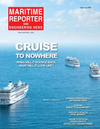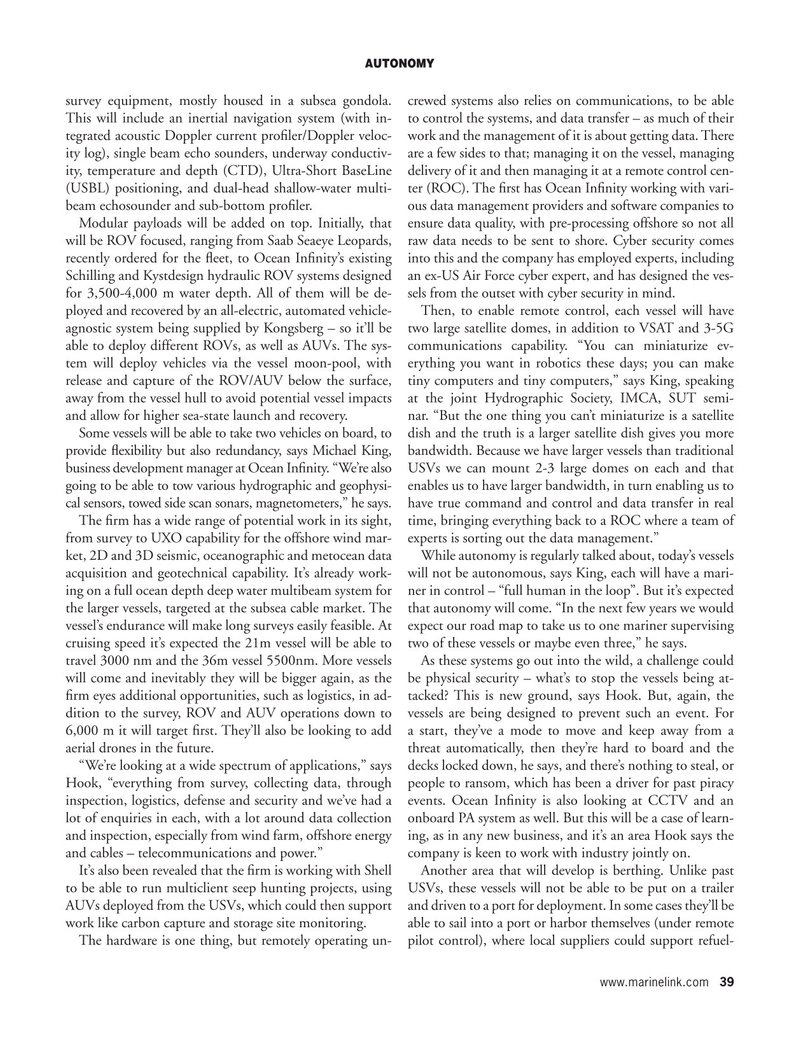
Page 39: of Maritime Reporter Magazine (February 2021)
Government Shipbuilding
Read this page in Pdf, Flash or Html5 edition of February 2021 Maritime Reporter Magazine
AUTONOMY survey equipment, mostly housed in a subsea gondola. crewed systems also relies on communications, to be able
This will include an inertial navigation system (with in- to control the systems, and data transfer – as much of their tegrated acoustic Doppler current pro? ler/Doppler veloc- work and the management of it is about getting data. There ity log), single beam echo sounders, underway conductiv- are a few sides to that; managing it on the vessel, managing ity, temperature and depth (CTD), Ultra-Short BaseLine delivery of it and then managing it at a remote control cen- (USBL) positioning, and dual-head shallow-water multi- ter (ROC). The ? rst has Ocean In? nity working with vari- beam echosounder and sub-bottom pro? ler. ous data management providers and software companies to
Modular payloads will be added on top. Initially, that ensure data quality, with pre-processing offshore so not all will be ROV focused, ranging from Saab Seaeye Leopards, raw data needs to be sent to shore. Cyber security comes recently ordered for the ? eet, to Ocean In? nity’s existing into this and the company has employed experts, including
Schilling and Kystdesign hydraulic ROV systems designed an ex-US Air Force cyber expert, and has designed the ves- for 3,500-4,000 m water depth. All of them will be de- sels from the outset with cyber security in mind. ployed and recovered by an all-electric, automated vehicle- Then, to enable remote control, each vessel will have agnostic system being supplied by Kongsberg – so it’ll be two large satellite domes, in addition to VSAT and 3-5G able to deploy different ROVs, as well as AUVs. The sys- communications capability. “You can miniaturize ev- tem will deploy vehicles via the vessel moon-pool, with erything you want in robotics these days; you can make release and capture of the ROV/AUV below the surface, tiny computers and tiny computers,” says King, speaking away from the vessel hull to avoid potential vessel impacts at the joint Hydrographic Society, IMCA, SUT semi- and allow for higher sea-state launch and recovery. nar. “But the one thing you can’t miniaturize is a satellite
Some vessels will be able to take two vehicles on board, to dish and the truth is a larger satellite dish gives you more provide ? exibility but also redundancy, says Michael King, bandwidth. Because we have larger vessels than traditional business development manager at Ocean In? nity. “We’re also USVs we can mount 2-3 large domes on each and that going to be able to tow various hydrographic and geophysi- enables us to have larger bandwidth, in turn enabling us to cal sensors, towed side scan sonars, magnetometers,” he says. have true command and control and data transfer in real
The ? rm has a wide range of potential work in its sight, time, bringing everything back to a ROC where a team of from survey to UXO capability for the offshore wind mar- experts is sorting out the data management.” ket, 2D and 3D seismic, oceanographic and metocean data While autonomy is regularly talked about, today’s vessels acquisition and geotechnical capability. It’s already work- will not be autonomous, says King, each will have a mari- ing on a full ocean depth deep water multibeam system for ner in control – “full human in the loop”. But it’s expected the larger vessels, targeted at the subsea cable market. The that autonomy will come. “In the next few years we would vessel’s endurance will make long surveys easily feasible. At expect our road map to take us to one mariner supervising cruising speed it’s expected the 21m vessel will be able to two of these vessels or maybe even three,” he says. travel 3000 nm and the 36m vessel 5500nm. More vessels As these systems go out into the wild, a challenge could will come and inevitably they will be bigger again, as the be physical security – what’s to stop the vessels being at- ? rm eyes additional opportunities, such as logistics, in ad- tacked? This is new ground, says Hook. But, again, the dition to the survey, ROV and AUV operations down to vessels are being designed to prevent such an event. For 6,000 m it will target ? rst. They’ll also be looking to add a start, they’ve a mode to move and keep away from a aerial drones in the future. threat automatically, then they’re hard to board and the “We’re looking at a wide spectrum of applications,” says decks locked down, he says, and there’s nothing to steal, or
Hook, “everything from survey, collecting data, through people to ransom, which has been a driver for past piracy inspection, logistics, defense and security and we’ve had a events. Ocean In? nity is also looking at CCTV and an lot of enquiries in each, with a lot around data collection onboard PA system as well. But this will be a case of learn- and inspection, especially from wind farm, offshore energy ing, as in any new business, and it’s an area Hook says the and cables – telecommunications and power.” company is keen to work with industry jointly on.
It’s also been revealed that the ? rm is working with Shell Another area that will develop is berthing. Unlike past to be able to run multiclient seep hunting projects, using USVs, these vessels will not be able to be put on a trailer
AUVs deployed from the USVs, which could then support and driven to a port for deployment. In some cases they’ll be work like carbon capture and storage site monitoring. able to sail into a port or harbor themselves (under remote
The hardware is one thing, but remotely operating un- pilot control), where local suppliers could support refuel- www.marinelink.com 39
MR #2 (34-49).indd 39 MR #2 (34-49).indd 39 2/4/2021 9:53:36 AM2/4/2021 9:53:36 AM

 38
38

 40
40
